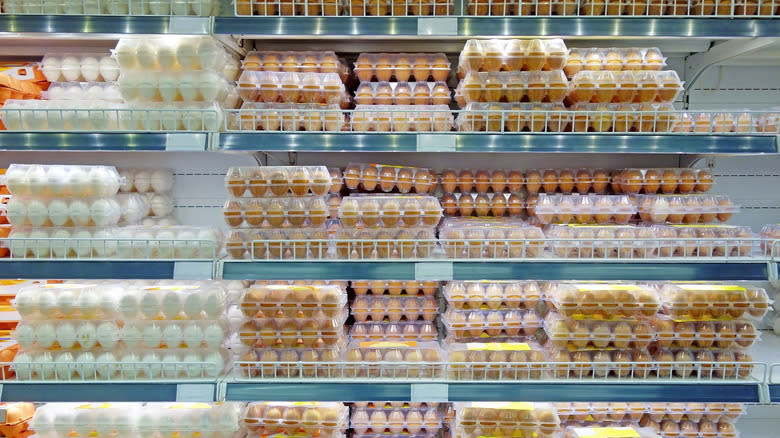Trader Joe's Owes Its Existence To Extra-Large Eggs

Trader Joe's is one of the most well-known grocery chains in America, noted for its proprietary products and its ability to sell them at prices that allow customers to save surprising amounts of money. Couple this with its unusually generous-for-their-industry employee benefits packages, and it stands out among its peers. And it owes its existence -- as well as many of these specific company traits -- to a batch of larger-than-usual eggs from 1962.
These eggs weren't simply a funny catalyst for Trader Joe's accidental success: They were directly responsible for the key traits we associate with the company today, like its in-house products and general affordability. Trader Joe's started as Pronto Markets under the ownership of Joe Coulombe (yes, there really was a "Trader Joe"), a local chain of less than a dozen California locations more akin to a convenience store than a large grocery chain. Until, that is, a local egg farmer came to Coulombe trying to unload a bunch of his oddly-sized eggs.
Read more: 22 Discontinued Trader Joe's Items We're Probably Not Getting Back
The Egg Deal Changed The Way The Company Thought About Suppliers

At issue for the egg farmer was a surplus of extra large AA eggs. The eggmonger didn't have enough of them to get a larger chain to take them off his hands, so he offered to sell them to Coulombe for the price of large AA eggs (which were 12% smaller than the ones he was trying to shift). Coulombe immediately jumped at the prospect, recognizing a good deal when he saw it and selling the eggs at the same price point as the smaller variety. Alongside this, he ran ads talking about how he was selling particularly big eggs at lower prices than you'd find at other grocery stores. It worked, and the eggs sold like gangbusters.
But the most important part of the story isn't that the eggs sold, but how they changed the way Coulombe did business and even how he thought about the grocery industry. Coulombe had spotted a niche here that the larger grocery chains had overlooked: If he could get products -- any products, really -- at a lower price point than his competitors, he could turn those savings around to the customer, attracting more business and ultimately making more money.
Coulombe Was Looking To Exploit Large Chains' Inflexibility

Coulombe's efforts were aimed at taking advantage of large food purveyors' focus on standardization. For the same reason grocery chains often eschew misshapen fruits, these companies won't buy products that don't fit within specific size ranges. Like Coulombe's eggs, many of these are sold by smaller producers who are quite motivated to shift their output for especially competitive prices, an idea which eventually became, in Coulombe's own words in his autobiography, a "product knowledge breakthrough." To this day, Trader Joe's still sells eggs that vary significantly in size and description.
This wasn't always based on product size or shape, either. Sometimes it simply involved finding a wine seller in Bordeaux who (unlike wholesalers) let Coulombe set his own prices, or exploiting a loophole exempting brie from tight U.S. import restrictions protecting the domestic cheese market. It was all about finding ways to save money (and allowing consumers to save money) without being beholden to product standardization at the cost of market efficiency, adapting as needed, and being willing to switch things up.
It's not necessarily unusual for large food companies to have strange or simply unexpected origin stories. The Cheesecake Factory started as a family business that was quite literally a factory that made cheesecakes, while the creation of Old Bay was due to a Jewish immigrant narrowly escaping the Holocaust. Even among these, though, Trader Joe's egg story stands out for creative use of the market.
Read the original article on Daily Meal